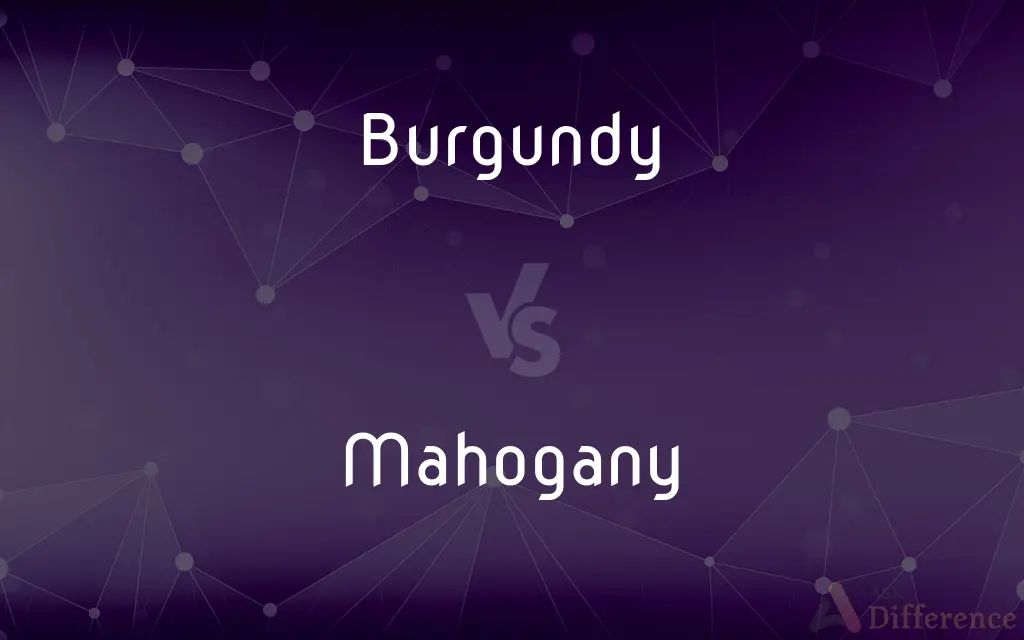Burgundy vs. Mahogany — What's the Difference?
By Fiza Rafique & Maham Liaqat — Updated on March 20, 2024
Burgundy is a deep red wine color, while mahogany is a reddish-brown, resembling the wood it's named after.

Difference Between Burgundy and Mahogany
Table of Contents
ADVERTISEMENT
Key Differences
Burgundy is a rich, dark red color inspired by the wine from the Burgundy region in France. It carries connotations of sophistication and depth, often associated with luxury items and fashion. Mahogany, on the other hand, is a warmer, reddish-brown hue, reminiscent of the mahogany wood commonly used in fine furniture. This color is often linked to stability and reliability, evoking a sense of earthiness and natural beauty.
While burgundy tends to have more purple undertones, giving it a cooler, more luxurious feel, mahogany leans towards orange or yellow undertones, which provide a warmer, more grounded appearance. These subtle differences in undertone and warmth make burgundy and mahogany suitable for different applications and aesthetic appeals. For instance, burgundy might be chosen for its richness and depth in formal attire or branding, whereas mahogany could be preferred for its natural, comforting qualities in interior design or wood finishes.
In the context of fashion and design, burgundy is often used in fall and winter collections, contributing to a cozy yet sophisticated atmosphere. Mahogany, with its wood-inspired origins, is a popular choice in furniture, hardwood flooring, and interior design, offering a classic and timeless look that enhances the warmth of a space.
The emotional and psychological impacts of these colors also differ. Burgundy, with its depth and intensity, can evoke feelings of passion and ambition, making it a popular choice for powerful and impactful designs. Mahogany, with its earthy and natural connotations, often instills a sense of stability and comfort, making it ideal for creating inviting and reassuring spaces.
Both colors offer versatility and depth, but their distinct undertones and associations make them suitable for different uses and atmospheres. Burgundy, with its association with wine and depth, is perfect for elegant and impactful designs, while mahogany's connection to wood and warmth makes it ideal for natural and comforting spaces.
ADVERTISEMENT
Comparison Chart
Hue
Deep red with purple undertones
Reddish-brown with orange/yellow undertones
Inspiration
Burgundy wine from France
Mahogany wood
Associations
Luxury, sophistication, depth
Stability, earthiness, natural beauty
Common Uses
Fashion, luxury branding, formal attire
Furniture, interior design, wood finishes
Emotional Impact
Passion, ambition, sophistication
Comfort, stability, natural warmth
Seasonality
Often used in fall and winter collections
Timeless, but especially popular in warm, cozy settings
Compare with Definitions
Burgundy
A deep red color inspired by Burgundy wine, symbolizing luxury and sophistication.
The burgundy dress at the gala exuded elegance and depth.
Mahogany
A reddish-brown color reminiscent of mahogany wood, associated with stability and warmth.
The mahogany wooden floor brought a warm, natural feel to the house.
Burgundy
Rich, dark red with subtle purple undertones.
The evening sky's burgundy hues were mesmerizing.
Mahogany
Warm reddish-brown with orange or yellow undertones.
The sunset's mahogany shades created a warm, inviting atmosphere.
Burgundy
Can evoke feelings of passion, ambition, and sophistication.
The burgundy accents in the office inspired a sense of ambition and drive.
Mahogany
Linked to earthiness, stability, and natural beauty.
The mahogany bookcase gave the room an earthy, grounded feel.
Burgundy
Often linked to luxury, sophistication, and depth.
The burgundy leather sofa added a touch of sophistication to the room.
Mahogany
Instills a sense of comfort, stability, and natural warmth.
The mahogany-toned decor in the lounge created a comforting and stable ambiance.
Burgundy
Preferred for its richness in fashion, branding, and special occasions.
The company's burgundy logo conveyed a sense of premium quality.
Mahogany
Popular in furniture, hardwood flooring, and interior design for its classic look.
The mahogany dining set became the centerpiece of the rustic kitchen design.
Burgundy
Burgundy (; French: Bourgogne [buʁɡɔɲ] (listen)) is a historical territory and a former administrative region of east-central France. It is named for the Burgundians, an East Germanic people who moved westwards beyond the Rhine during the late Roman period.The name Burgundy has historically denoted numerous political entities, including kingdoms and duchies spanning territory from the Mediterranean to the Low Countries.
Mahogany
Mahogany is a straight-grained, reddish-brown timber of three tropical hardwood species of the genus Swietenia, indigenous to the Americas and part of the pantropical chinaberry family, Meliaceae.
Burgundy
A region and former duchy of east central France, centred on Dijon. The region is noted for its wine.
Mahogany
Hard reddish-brown timber from a tropical tree, used for quality furniture.
Burgundy
Any of various red or white wines produced in the Burgundy region of France.
Mahogany
The tropical tree which produces mahogany.
Burgundy
Any of various similar wines produced elsewhere.
Mahogany
Any of several tropical American evergreen trees of the genus Swietenia of the family Meliaceae, especially S. mahagoni and S. macrophylla, valued for their hard, reddish-brown wood.
Burgundy
Burgundy A dark grayish or blackish red to dark purplish red or reddish brown.
Mahogany
The wood of any of these trees, used in making furniture and musical instruments.
Burgundy
Alternative case form of Burgundy(red wine).
Mahogany
Any of several trees of the family Meliaceae having similar wood, such as African mahogany.
Burgundy
(color) A dark red colour tinged with purple, like that of Burgundy (red) wine.
Mahogany
Any of several trees of other families having similar wood, such as Philippine mahogany.
Burgundy
Of a deep purple red color like that of Burgundy wine.
Mahogany
The wood of any of these trees.
Burgundy
An old province of France (in the eastern central part).
Mahogany
A moderate reddish brown.
Burgundy
A richly flavored wine, mostly red, made in Burgundy, France.
Mahogany
(uncountable) The wood of any of various tropical American evergreen trees, of the genus Swietenia, mostly used to make furniture.
Burgundy
A former province of eastern France that is famous for its wines
Mahogany
(countable) Any of the trees from which such wood comes.
Burgundy
Red table wine from the Burgundy region of France (or any similar wine made elsewhere)
Mahogany
(regional) A Cornish drink made from gin and treacle.
Burgundy
A dark purplish red to blackish red
Mahogany
A reddish-brown color, like that of mahogany wood.
Mahogany
A table made from mahogany wood; a dining table.
Mahogany
Made of mahogany.
Mahogany
Having the colour of mahogany; dark reddish-brown.
Mahogany
A large tree of the genus Swietenia (Swietenia Mahogoni), found in tropical America.
Mahogany
The wood of the Swietenia Mahogoni. It is of a reddish brown color, beautifully veined, very hard, and susceptible of a fine polish. It is used in the manufacture of furniture.
Mahogany
A table made of mahogany wood.
Mahogany
Wood of any of various mahogany trees; much used for cabinetwork and furniture
Mahogany
Any of various tropical timber trees of the family Meliaceae especially the genus Swietinia valued for their hard yellowish- to reddish-brown wood that is readily worked and takes a high polish
Common Curiosities
How does mahogany get its name?
Mahogany is named after the mahogany wood, known for its reddish-brown color, reflecting warmth and natural beauty.
Can burgundy and mahogany be used interchangeably in design?
While both are rich, warm colors, their different undertones and associations make them suitable for distinct applications and atmospheres.
What makes burgundy a popular choice in fashion?
Burgundy's depth and sophistication make it a favored choice for elegant attire and accessories, especially in fall and winter.
Is burgundy considered a seasonal color?
Yes, burgundy is often associated with fall and winter, due to its deep, rich tone that complements the colors of these seasons and the sense of warmth and sophistication it brings.
Why is mahogany a common color for furniture?
Mahogany's warm, reddish-brown hue and association with the durability and beauty of mahogany wood make it ideal for timeless furniture pieces.
What are some complementary colors for burgundy in design?
Gold, navy, cream, and dark green complement burgundy well, creating elegant and sophisticated color palettes.
What emotions do burgundy and mahogany typically evoke in people?
Burgundy often evokes feelings of power, passion, and sophistication, whereas mahogany can instill a sense of reliability, warmth, and comfort.
What is the primary inspiration behind the color burgundy?
Burgundy is inspired by the color of Burgundy wine, originating from the Burgundy region in France, symbolizing depth and luxury.
How do the undertones of burgundy and mahogany affect their use in interior design?
Burgundy, with its purple undertones, lends a cooler, more luxurious feel, ideal for accents and statement pieces, while mahogany's warmer undertones create a cozy, inviting environment, perfect for flooring and furniture.
Can mahogany be used in modern design settings?
Absolutely, mahogany can be incorporated into modern design through sleek furniture pieces or accents, adding warmth and a touch of natural beauty to contemporary spaces.
What types of wood are typically stained to look like mahogany?
Woods like cherry and maple are often stained to mimic mahogany's reddish-brown hue, offering a more affordable alternative while maintaining a similar aesthetic.
How do cultural perceptions of burgundy and mahogany differ?
Cultural perceptions can vary; burgundy might be associated with nobility and wealth in some cultures, while mahogany may represent earthiness and stability, reflecting its natural wood origins.
How does lighting affect the appearance of burgundy and mahogany colors in a room?
Natural lighting can enhance the warmth and depth of mahogany and can brighten up burgundy's rich hue, while artificial lighting can either warm up or cool down their appearances depending on the bulb color temperature.
Are there any industries where burgundy is a particularly popular color choice?
Besides fashion, burgundy is popular in the automotive industry for luxury vehicles and in branding for companies aiming to project elegance and exclusivity.
How do fashion designers typically use burgundy and mahogany in their collections?
Fashion designers use burgundy to add depth and richness to their collections, particularly in fall and winter, while mahogany might be used in accessories or leather goods for its natural elegance and warmth.
Share Your Discovery

Previous Comparison
Peptization vs. Coagulation
Next Comparison
Recompense vs. CompenseAuthor Spotlight
Written by
Fiza RafiqueFiza Rafique is a skilled content writer at AskDifference.com, where she meticulously refines and enhances written pieces. Drawing from her vast editorial expertise, Fiza ensures clarity, accuracy, and precision in every article. Passionate about language, she continually seeks to elevate the quality of content for readers worldwide.
Co-written by
Maham Liaqat













































